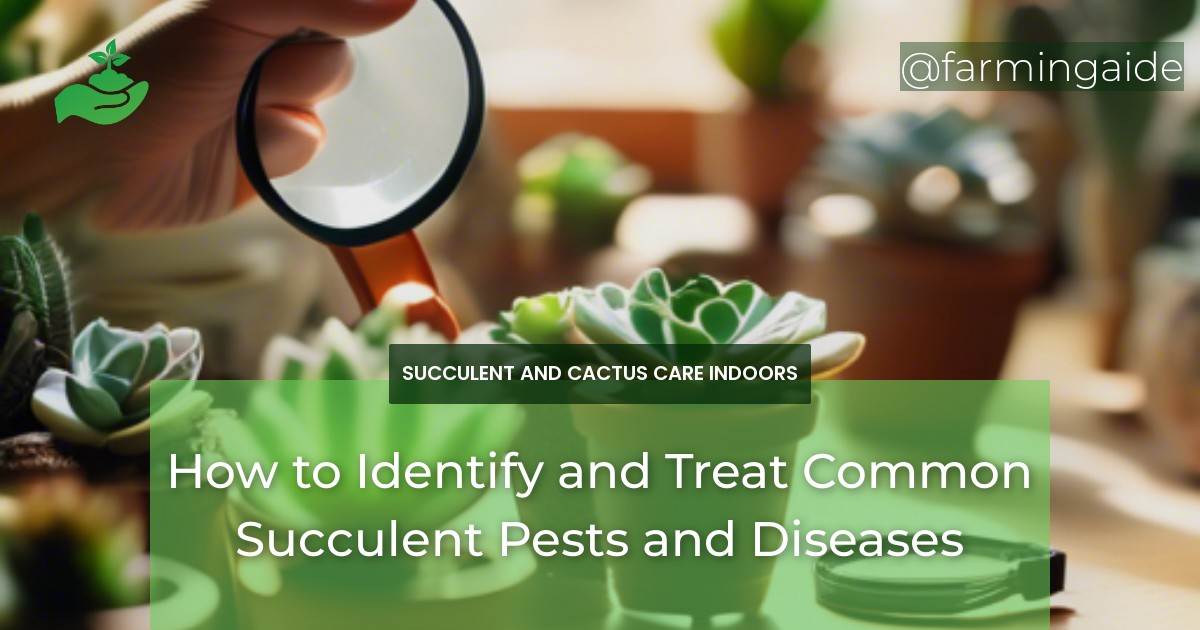Succulents are beloved for their unique beauty and low-maintenance care, but even the most diligent succulent enthusiasts can encounter pests and diseases that threaten the health of their plants. In this article, we’ll delve into the world of succulent pests and diseases, exploring the common culprits, signs of infestation, and effective treatment methods to keep your succulents thriving.
Key Takeaways
- Common succulent pests include mealybugs, aphids, and scale insects.
- Fungal diseases like root rot can be caused by overwatering.
- Natural remedies like neem oil and insecticidal soap can control pest infestations.
- Chemical treatments should be used sparingly and with caution.
- Preventative care, such as proper watering and pruning, is key to maintaining healthy succulents.
Introduction to Succulent Pests and Diseases
Succulents are susceptible to a range of pests and diseases that can quickly spread and wreak havoc on your plant collection. Pests can feed on sap, leaves, and stems, while diseases can cause rot, discoloration, and even death. Early detection and treatment are crucial to saving your succulents.
By understanding the common types of pests and diseases affecting succulents, you can take proactive measures to prevent infestations and infections. This article will guide you through the identification and treatment of succulent pests and diseases, as well as provide valuable tips for preventative care.
Common Types of Pests Affecting Succulents
Mealybugs, aphids, and scale insects are among the most common pests that target succulents. These pests can be introduced through contaminated soil, infected plants, or even on your clothing or tools.
Mealybugs, for instance, feed on sap, causing weakened plants and distorted growth. Aphids, on the other hand, secrete a sticky substance that attracts ants and promotes fungal growth.
Recognizing Signs of Disease in Succulents
Fungal diseases, such as root rot, can be caused by overwatering, poor drainage, or high humidity. Soft, mushy stems or leaves, as well as black or brown discoloration, are indicative of fungal infections.
Regularly inspect your succulents for signs of pests or disease, such as tiny eggs, white powdery residue, or soft, rotting tissue.
Identifying Specific Pests and Diseases
ALSO READ
Mealybugs and Their Impact on Succulents
Mealybugs are tiny, white, cotton-like insects that feed on succulent sap. They can cause stunted growth, yellowing leaves, and weakened plants.
Treatment for mealybugs involves isolating infected plants, removing affected areas, and applying insecticidal soap or neem oil.
Aphids and Scale Insects on Succulents
Aphids are small, soft-bodied insects that feed on sap, while scale insects have a hard, armored shell and feed on sap or plant tissue.
Treatment for aphids and scale insects includes pruning infested areas, applying insecticidal soap, and introducing natural predators like ladybugs or lacewings.
ALSO READ
Root Rot and Other Fungal Diseases
Root rot is a common fungal disease caused by overwatering, poor drainage, or high humidity. It can cause black or brown roots, soft stems, and plant death.
Treatment for root rot involves repotting the succulent in well-draining soil, reducing watering, and applying fungicides.
Effective Treatment Methods
Natural Remedies for Pest Control
Natural remedies like neem oil, insecticidal soap, and horticultural oil can control pest infestations without harming beneficial insects.
Neem oil, derived from the seeds of the neem tree, is toxic to pests but safe for humans and pets.
Chemical Treatments for Severe Infestations
Chemical treatments should be used sparingly and with caution, as they can harm beneficial insects and the environment.
Systemic insecticides, such as imidacloprid, can be effective against severe infestations but require careful application to avoid harming other plants and wildlife.
Preventing and Treating Fungal Diseases
Fungal diseases can be prevented by maintaining good air circulation, reducing humidity, and avoiding overwatering.
Treatment for fungal diseases involves applying fungicides, pruning affected areas, and improving air circulation.
Preventative Care for Succulents
Best Practices for Succulent Care
Regularly inspect your succulents for signs of pests or disease, and isolate infected plants to prevent the spread of infestations.
Proper watering, pruning, and fertilization can help maintain healthy succulents and prevent pest and disease issues.
Creating a Healthy Environment for Succulents
A well-ventilated, dry environment with moderate temperatures can help prevent fungal diseases and pest infestations.
Avoid overwatering, which can lead to root rot and other fungal diseases.
Conclusion: Keeping Your Succulents Healthy
By understanding the common types of pests and diseases affecting succulents, you can take proactive measures to prevent infestations and infections. Regularly inspect your succulents, maintain good air circulation, and avoid overwatering to keep your plants thriving.
Remember, early detection and treatment are crucial to saving your succulents from pests and diseases. With the right knowledge and care, you can enjoy the beauty and benefits of healthy, thriving succulents.
| Pest/Disease | Signs and Symptoms | Treatment |
|---|---|---|
| Mealybugs | White, cotton-like residue; weakened plants | Insecticidal soap, neem oil, isolation |
| Aphids | Soft, sticky residue; distorted growth | Insecticidal soap, neem oil, natural predators |
| Root Rot | Soft, black or brown roots; plant death | Repotting, fungicides, reduced watering |
| Preventative Care | Description |
|---|---|
| Regular Inspection | Regularly inspect succulents for signs of pests or disease |
| Good Air Circulation | Maintain good air circulation to prevent fungal diseases |
| Proper Watering | Avoid overwatering, which can lead to root rot and other fungal diseases |


